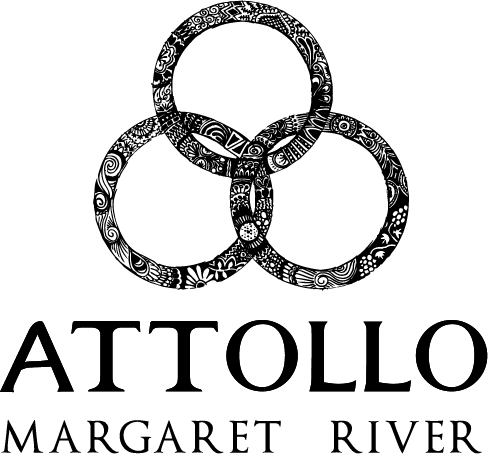Cabernet Sauvignon 2017
The Attollo Cabernet Sauvignon 2017 was made from a sustainably farmed parcel of fruit from the Wilyabrup Subregion in the Margaret River region. The fruit was hand tended throughout the growing season following solely organic practices with no herbicide. The wine was made utilising a “hands-off” approach, with a focus on limited additions, gravity flow operations and Biodynamique principles. The vinification aimed to create an elegant wine with structure and depth that will provide ageability for the medium term, depending on your cellaring conditions.
The 2017 growing season was a very cool season, with mild even ripening and a very lucky warm dry finish. Cyclonic rains in January gave an unseasonal drink to the vines, which resulted in great freshness and higher than average yields. Thankfully, the growing season extended with the driest April on record, with moderate perfect ripening temperatures. 2017 started out cool and ended up being mild and long, with fresh moderately flavoured reds with fine savoury tannin. Bird pressure was insignificant as well- which was a first.
The Cabernet Sauvignon for this wine was sourced from the Wilyabrup Sub-region of the Margaret River Appellation. The fruit was sourced from vines planted in 1995, so twenty one year old vines, grown using a spur pruned VSP trellis on karri loam soils. The site has a gentle north aspect and moderate vigour- just requiring a light hedge if at all—perfect natural balance. The fruit was grown sustainably following organic practices, with no herbicide use.
2.5t of Pusey Road Wilyabrup Cabernet Sauvignon was hand harvested on the 18th April 2017 [Biodynamic fruit day]. The target was fresh fruit flavours, ripe tannin and elegant balance. The fruit was chilled over night and then destemmed and conveyed to an open fermenter to soak for a few days. The fruit warmed up slowly and ferment initiated naturally after this time and the ferment was plunged twice daily for the duration. The Cabernet was left on skins for 3 weeks to build mid palate sweetness and structure through extended maceration. Once deemed ready, the Cabernet was basket pressed to barrel, of which 20% was new French Oak [Taransaud 5 Year Seasoned French Oak]. The Cabernet was left to go through malolactic ferment on lees, after which a small amount of sulphur was added and it was matured on lees for 6 months before it was gravity racked off lees and blended and returned to barrel. The final wine was blended after 14 months maturation in July 2018 and left to clarify and stabilise in stainless steel drums. The wine was bottled without fining or filtration in November 2018.
pH 3.61
Titrateable Acidity [TA] 5.7g/L
Residual Sugar [RS] 0.14/L
Volatile Acidity [VA] 0.62g/l
Alcohol 13.6%
Cases Bottled December 2014
790L
175 6 pack screw cap
Cellaring Best
Best 2017-20, Maximum 2026
Taste [20/11/2018
The wine has a moderately deep red centre with a pink red hue. The nose is filled with red and black fruits, plum, licorice, and hints of freshly turned earth and blackcurrant in the background. The palate is deliberately moderate with restraint and elegance. The wine currently has a supple and flavorsome midpalate, with lovely fine dry tannins, affording a dry finish. The aim is to make something Intensely Subtle. At first impression – it may seem a bit light, a bit lacking, but I pose the question – is it? Enjoy a glass, or the bottle and think about it.
